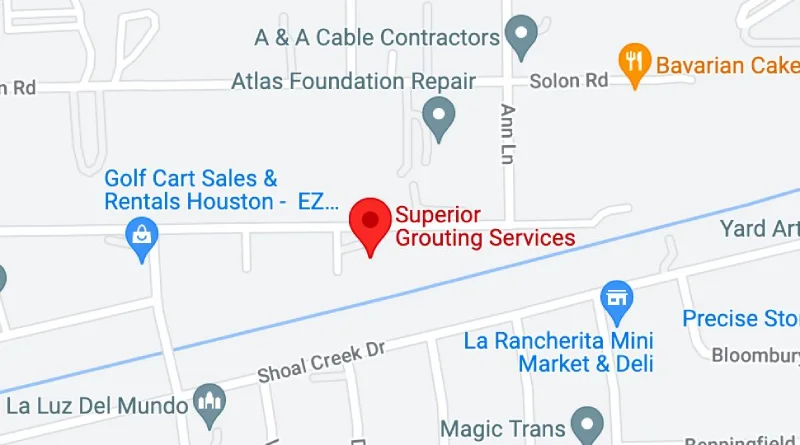What Is Polyurethane Grouting in Houston, TX?

Polyurethane grouting—also called polyurethane injection grouting or foam grouting—is a geotechnical and water-control method that injects expanding polyurethane grout into voided or weak soils. In a dynamic, flood-prone market like Houston, TX, the service is trusted by industrial plant managers, municipal engineers, rail operators, and port authorities that need rapid, non-disruptive stabilization under critical infrastructure.
By reacting within seconds, the closed-cell foam fills hidden cavities, densifies loose materials, and seals off groundwater pathways, all while adding almost no weight to Houston’s compressible Gulf Coast clays.
Key Takeaways
- Polyurethane grouting uses a two-component resin that expands up to 30×, delivering concrete lifting, soil stabilization, and leak sealing in one operation.
- Houston’s expansive clays, fluctuating groundwater, and intense stormwater events make fast-curing, water-resistant polyurethane grout far more dependable than cementitious alternatives.
- Injection holes are only ⅝–¾ in., so traffic lanes, conveyor aisles, and production floors reopen within hours—often before the next shift.
- Closed-cell foam resists water absorption, meets NSF/ANSI 61 standards when specified, and remains stable through hurricanes, coastal surges, and aggressive chemical environments common at petrochemical facilities.
- Choosing an experienced Houston polyurethane grouting contractor ensures data-driven lift control, real-time monitoring, and warranties that can exceed ten years for both elevation and water cut-off.
Why Houston’s Geography Demands Polyurethane Grouting
Houston infrastructure sits on alternating layers of Baytown clay, Beaumont formation, and sand lenses that expand, shrink, and wash out. Heavy truck traffic to the Port of Houston, constant rail movements, and frequent rainfall magnify settlement. Traditional cement slurry adds 110-135 lb/ft³ to soils already near failure. In contrast, polyurethane grout weighs 2-15 lb/ft³, so it strengthens weak zones without overburdening them. Its hydrophobic nature also cuts off leaks around manholes, box culverts, and underground utility corridors where groundwater infiltration inflates treatment costs.
Common Houston Pain Points Solved by Polyurethane Injection
- Bridge approach “bumps” on I-10 and Beltway 8.
- Settled gantry crane rail pads at petrochemical docks.
- Leaking sanitary sewer manholes near Buffalo Bayou.
- Voided industrial flooring at refrigerated warehouses where condensation undermines subgrade soils.
- Tunnel and shaft water infiltration during hurricane-induced storm surges.
How Polyurethane Grout Works
Expansion Chemistry
A polymeric isocyanate and a polyol blend meet at the static mixer in the injection gun. They expand quickly, forming a rigid, closed-cell foam that:
- Bonds to concrete, steel, and rock.
- Fills micro-fractures while exerting lower injection pressure than cement-based grout.
- Reaches 90 % strength within 15 minutes at 70 °F, crucial for Houston’s time-sensitive industrial corridors.
Injection Procedure
- Survey crews map voids with ground-penetrating radar and dynamic cone penetrometer tests.
- ⅝–¾ in. holes are drilled on a tight grid (18–36 in. spacing) to minimize disruption to slabs or pavements.
- Packers are installed; the pump delivers polyurethane grout at controlled flow.
- Technicians monitor laser or LIDAR targets; once target lift or pressure is met, ports are sealed with high-strength epoxy.
- Surface is ready for traffic in 30–60 minutes, fully serviceable within a day.
What Is the Difference Between Polyurethane Grouting and Mudjacking?
Polyurethane grouting uses a two-part, high-density foam that expands, fills voids, and cures in minutes; mudjacking relies on a heavy cement-based slurry that can take days to reach strength and adds significant dead load. In industrial Houston settings where downtime is expensive and soils are moisture sensitive, lightweight polyurethane injection is the preferred concrete-lifting technique.
Benefits Over Cementitious Grouting
| Factor | Polyurethane Grout | Cementitious Grout |
| Cure Time | Minutes | Days |
| Unit Weight | 2-15 lb/ft³ | 110-135 lb/ft³ |
| Hole Diameter | ⅝–¾ in. | 1½–2 in. |
| Water Resistance | Closed-cell, hydrophobic | Moderate, porous |
| Downtime | < 24 hrs | Multiple days |
| Lift Precision | ± ⅛ in. | ± ½–¾ in. |
Because polyurethane grouting exerts less pressure and adds negligible weight, it is the preferred solution for Houston’s soft, moisture-sensitive soils. The foam’s closed-cell structure blocks capillary water rise, an essential feature when Gulf Coast tides and stormwater surge threaten below-grade structures.
Industrial and Municipal Applications Across Houston
Heavy-Duty Pavements and Port Infrastructure
Container yards, roll-on/roll-off ramps, and railroad crossings experience constant load cycles. When slabs settle, operations slow and equipment suffers damage. Polyurethane concrete lifting restores grade overnight, eliminating downtime penalties and safety hazards.
Municipal Utilities and Sewer Systems
Groundwater infiltration can overwhelm treatment plants. Injection grouting seals joints, cracks, and pipe penetrations in sanitary sewers, lift stations, and stormwater outfalls—without bypass pumping or open-cut excavation.
Petrochemical Plants and Refineries
Process areas rely on perfectly flat foundations to maintain pipe slope, flow, and pump alignment. Polyurethane soil stabilization zeros out voids below equipment pads and containment berms while withstanding chemical spills that would deteriorate cement slurry.
Rail and Transit Corridors
Ballasted deck bridges, subway portals, and track slabs require precise alignment. Foam grout stabilizes base soils, mitigates pumping, and supports high axle loads, keeping METRORail and freight traffic on schedule.
Step-By-Step Timeline for a Typical Houston Project
- Pre-Job Meeting: Review traffic control, safety, and Injection Plan.
- Utility Locates: 811 tickets plus private locator for plant or port conduits.
- Mobilization: Self-contained grout rig with heated hoses; generator or on-board power.
- Drilling & Port Installation: 4–8 hours for an average 5,000 ft² pavement section.
- Injection & Monitoring: Technician injects, operator tracks lift with laser; average 30–60 lb of resin per cubic foot of void.
- Finish Work: Ports trimmed and patched; slab cleaned, markings repainted if needed.
- Post-Project Report: Elevation data, injected volumes, photos, and warranty documentation.
Environmental and Regulatory Considerations
- Hydrophobic polyurethane resins can be specified to meet NSF/ANSI 61 for contact with potable water, supporting work near aquifers and raw-water pipelines.
- Cured foam is inert, non-leachable, and has no VOC emissions after reaction, aligning with Houston-Galveston Area Council (H-GAC) sustainability initiatives.
- Small injection footprints reduce spoil generation, lowering trucking and landfill costs.
Selecting a Houston Polyurethane Grouting Contractor
- Experience with Gulf Coast geologies—ask for project examples at Port Houston, Hobby Airport, or Ship Channel industrial sites.
- NASSCO, ACI, or ICRI certifications for chemical grout injection.
- Fleet of temperature-controlled grout rigs, ensuring consistent mix ratios even during Houston’s 100 °F summers.
- Real-time monitoring tools: digital flow meters, pressure gauges, and laser leveling.
- Written warranty covering both lift tolerance and water infiltration prevention.
When qualifying vendors, request references and verify insurance levels suitable for high-value industrial facilities. A reputable Houston polyurethane grouting contractor protects your assets, schedules, and budget.
Maintenance and Service Life
Closed-cell polyurethane foam has documented durability beyond 15 years in Houston’s harsh Gulf environment. Annual or biennial elevation surveys, paired with CCTV inspection of sealed utilities, catch minor movements early. Small “touch-up” injections return grade quickly, preserving investment and preventing progressive settlement that could jeopardize operations or worker safety.
Conclusion
Polyurethane grouting in Houston, TX is a proven, fast-acting solution for soil stabilization, concrete lifting, and water infiltration repair across heavy-duty industrial and municipal infrastructure. Its closed-cell foam chemistry, lightweight profile, and rapid cure let asset owners resolve settlement or leaks without shutting down key facilities. By partnering with a qualified Houston polyurethane grouting contractor, you secure data-driven injection plans, minimal downtime, and long-term performance—even through Gulf Coast hurricanes and relentless traffic loads.
Ready to evaluate your site? Contact Superior Grouting for a no-obligation assessment and keep your critical operations running on solid ground.


